Last winter, I sowed wheat with my kids. As we were spreading the seeds and covering them with compost, we talked about the different ways we eat wheat and how we wanted to eat this crop when it matured in the spring. The idea that came out on top was banana bread.
Spring came, we harvested our wheat, but no banana bread.
I’ll get to why that is, but first let me share how I have grown wheat and how you might grow some of your own.
When to sow wheat
Wheat is a grass, just like all those grasses that pop up in your garden after the first rains each fall.

So that’s when I sow wheat in Southern California: the fall, or early winter if the rains are late to arrive.
Some dates I have sown in the past and grown good crops include November 2, November 10, December 10, and February 1.
Can we also sow wheat in the spring or summer, as is done in locations with colder winters, and get a good crop? Maybe. I sowed a row of wheat (with oats and barley) on July 18, 2024, and it grew pretty well and formed acceptable heads of grain ready for harvest in October.
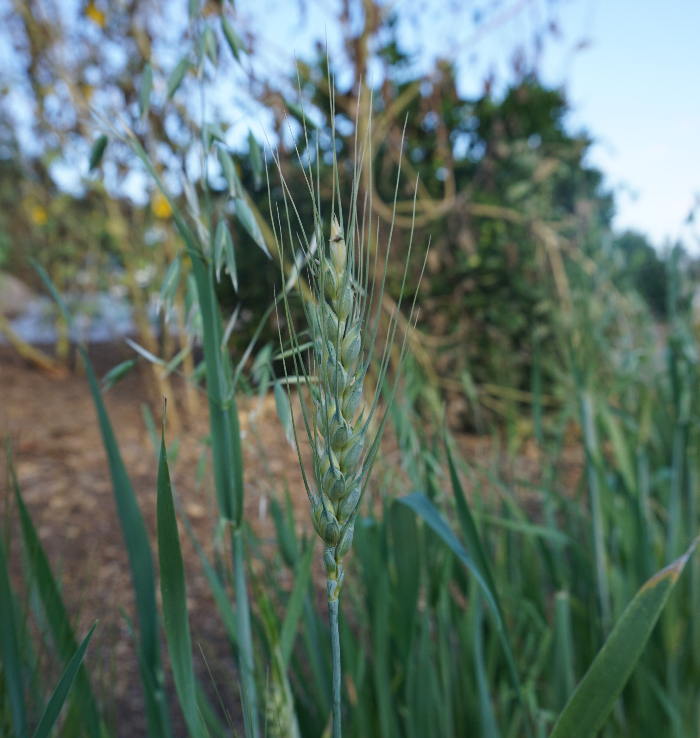
But my crops grown through the winter have been more robust. It’s also cheaper and easier to grow wheat through the winter in Southern California since that is when we get our rains so if I were growing one crop per year I’d choose winter.
Nonetheless, it’s nice to know that a decent crop of wheat can also be grown through summer in Southern California. This crop was useful to me through summer as I used some of the grass to feed my chickens and then in fall some of the grain heads also went to the chickens.
How to sow wheat
Wheat seeds are also sometimes called wheat berries or kernels. It’s what is ground up into flour, and it is also what we sow in the ground to sprout into new plants.
You can broadcast wheat seeds over a large area or sow them in rows. The seeds ought to be around a half-inch apart, but spacing is not critical. Cover the seeds with a half-inch of dirt or even better, compost.
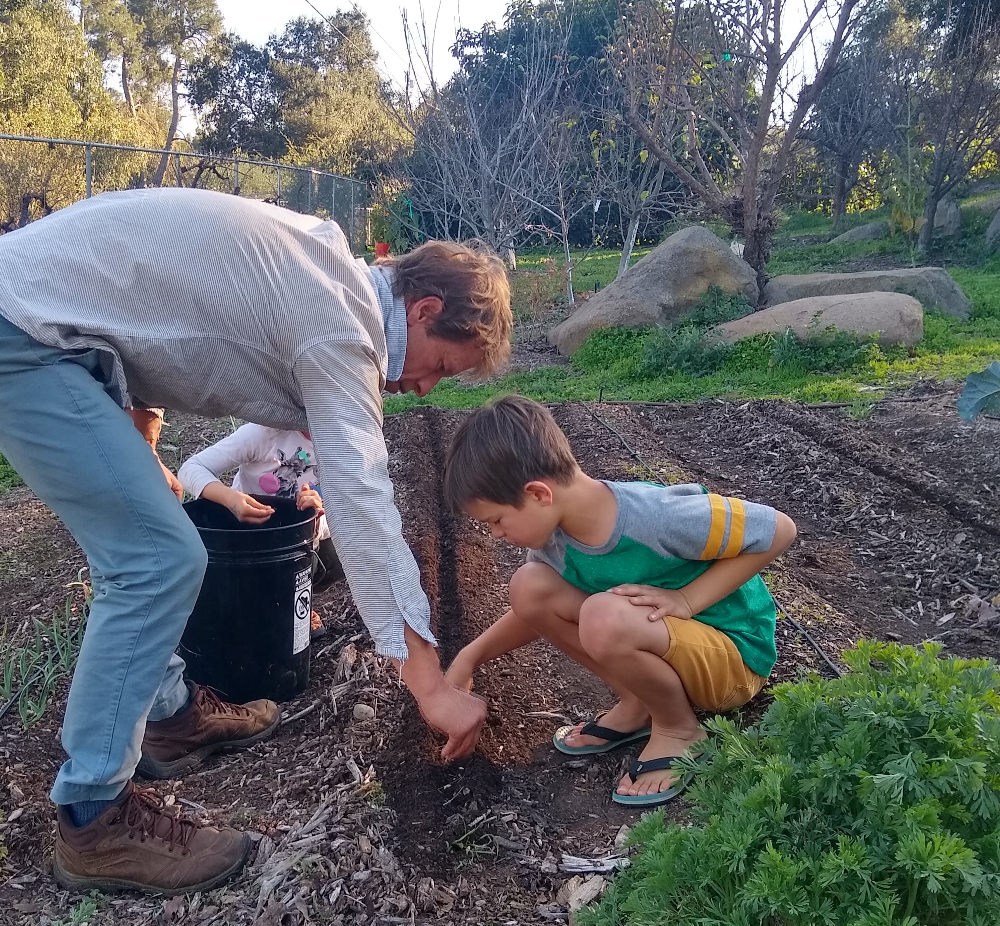
Birds like to find your wheat seeds and eat them. Birds will also eat the wheat seedlings right after they’ve germinated. If this happens, then cover with netting or straw for the first few weeks.
If you sow after fall rains have soaked the dirt, then you probably won’t have to irrigate. If you sow before there’s been more than an inch of rain, then you’ll probably need to water until the wheat seedlings are up and growing, and then the fall and winter rains might take care of them.
Some years I’ve had to irrigate my wheat, some years I haven’t.
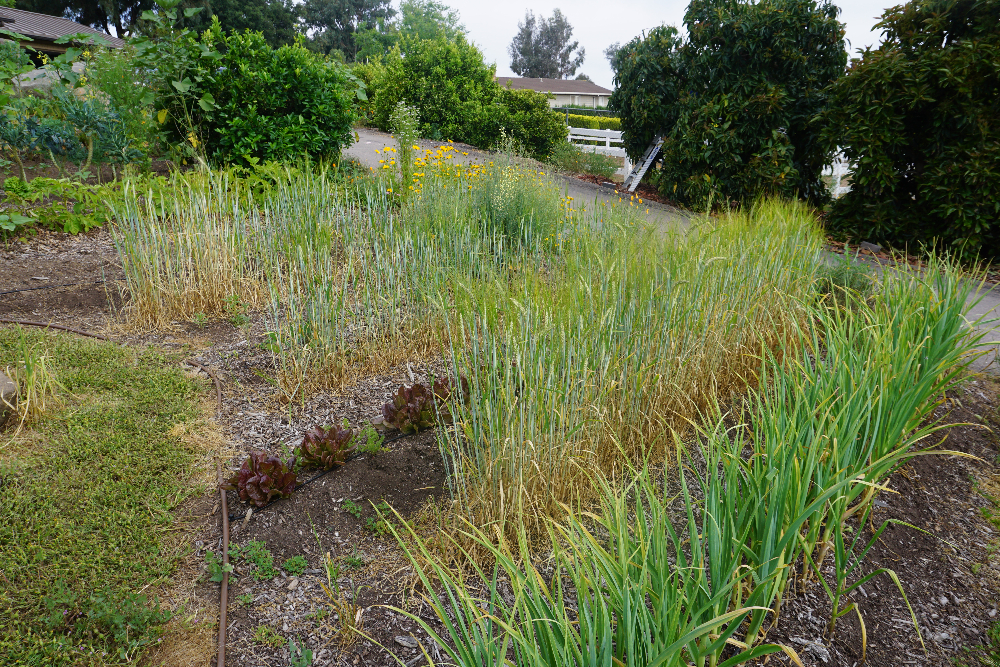
When and how to harvest
Wheat plants look like tall grass until they form heads of grain, and then they look iconic.
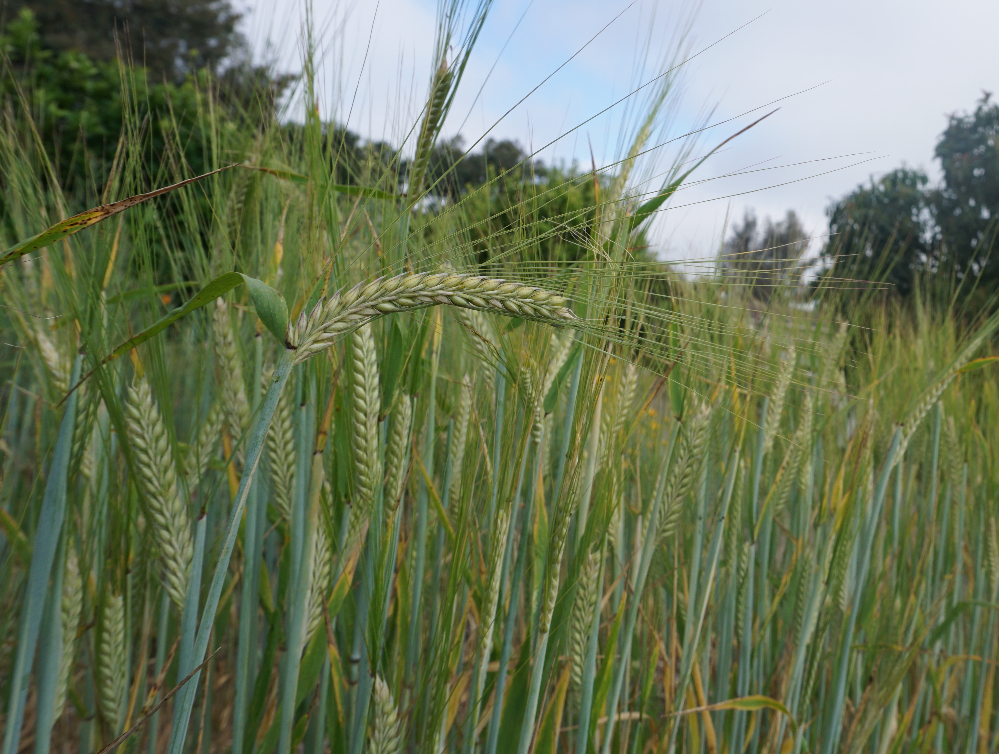
You want to let the grain heads fatten and dry before harvesting. An advantage we have in Southern California is no rain from spring through summer (usually) so harvest is easy for our winter-grown wheat. Folks in other parts of the country have to be concerned about spring rains causing their wheat to fall over and even sprout.
My harvests have always taken place in May or June.
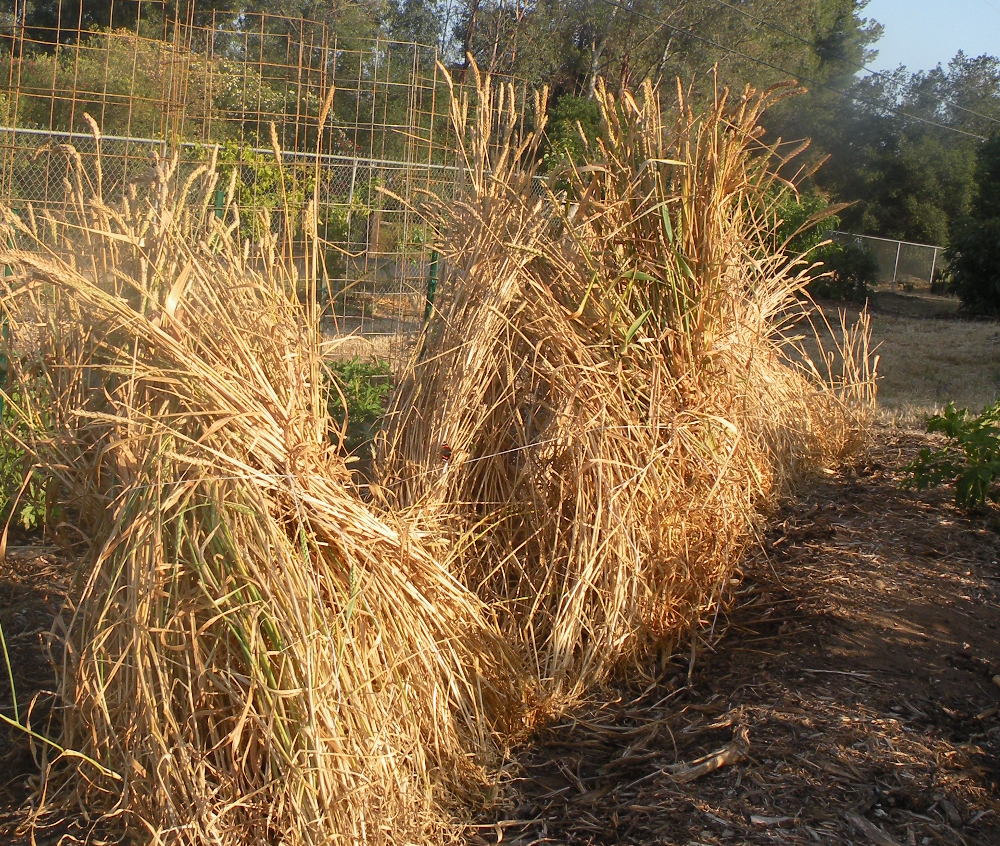
Processing and using
Here is where I treat the wheat differently according to how I’m going to use it. If I’m going to use it as food for the chickens, then I cut a handful of stalks each day to give to the birds. They peck the seeds off, and the straw becomes part of their floor or bedding that they eventually turn into compost.
If I’m going to eat the wheat myself, then there’s a lot more work to be done.
Threshing and winnowing
Rather than cutting low on the stalk, I take time to cut high, just under the heads of grain either with scissors or a sickle saw, or I snap the head off with a quick jerk of my hand. It’s tedious, but it makes threshing and winnowing faster and less dusty.
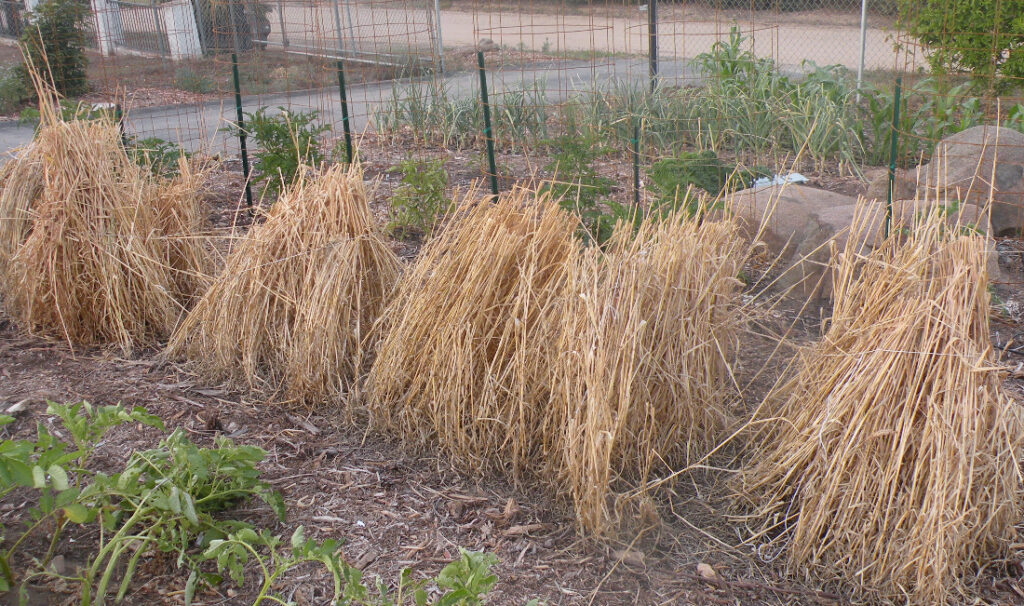
Threshing is separating the seeds from all the stuff attached to the seeds, the waste, called chaff.
As gardeners threshing a small amount of grain, we must use techniques similar to farmers in poor countries who can’t afford the machinery that farmers in richer countries use. The first time I threshed wheat, I spread it out on a tarp and whacked it with a homemade wooden club, as I recalled farmers in Lesotho, Africa, doing with their harvests of sorghum. Here’s a video I took of such threshing:
There are many other ways to thresh wheat. I’ve tried a few, from putting the grain heads in a pillow case and whacking it on the ground to rubbing the grain heads between gloved hands. But this year, I used kids in boots.
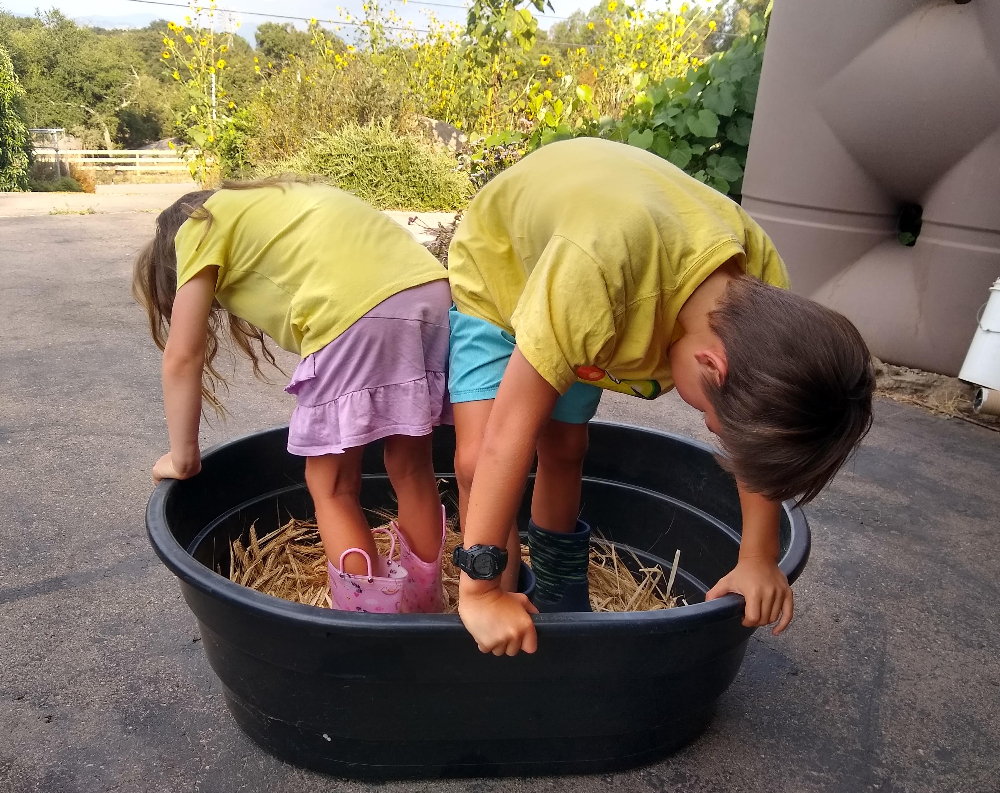
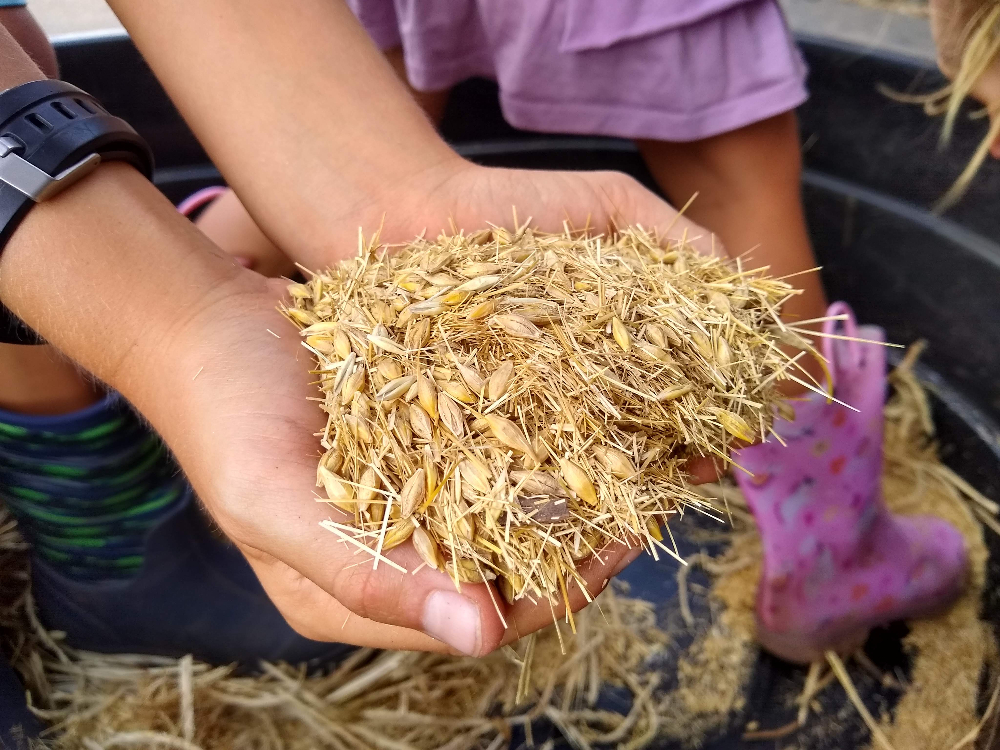
Winnowing is isolating the wheat seeds by letting the chaff blow away in the wind. Our yard is not a windy place so I set up a fan to help winnow.

My kids had a fun time threshing and winnowing, but I like that they also now have an understanding of many items and English words related to these actions: thresh, thrash, winnow, chaff, hull, straw, grain.
It’s only been a handful of generations since most Americans were farmers. We’re limited in our understanding of history and literature if we know little about the production of food.
My kids can now better understand the part of the Bible where John the Baptist talks about Jesus: “His winnowing fork is in His hand, and He will thoroughly clear His threshing floor; and He will gather His wheat into the barn, but He will burn up the chaff with unquenchable fire.” (Matthew 3:12 and Luke 3:17)
So growing wheat in our gardens gives us more than food; it can pay a spectrum of dividends.
Wheat varieties
What our wheat crop this year did not pay was a dividend of banana bread, however. I totally disappointed my kids!
What happened was we threshed and threshed the wheat but could not get the hulls to loosen and slough off the kernels. I tried more abrasive methods, all of which failed to dislodge the hulls without causing a lot of damage to the seeds.
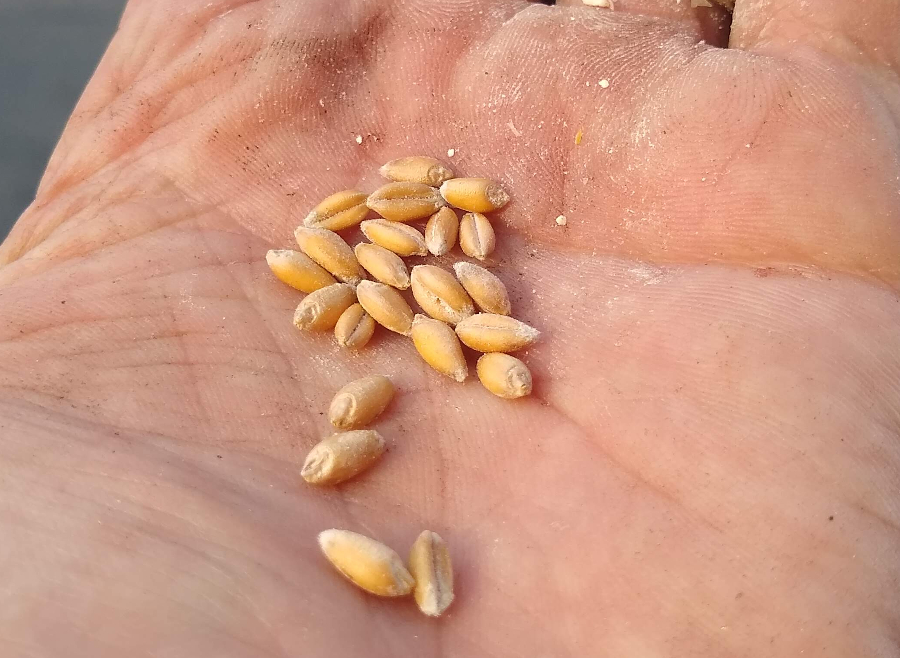
Then I thought, Wait, what variety is this? Is this not White Sonora? I checked my notes but I hadn’t recorded the variety. I knew it was seed that I had saved from the previous year’s crop, but I couldn’t find a record of the variety for that crop in my notes either.
I think I unwittingly sowed a variety that I had originally bought to grow as a cover crop. I blew it. So all of this year’s wheat has been going to the chickens, who aren’t bothered by hulls covering the seed.
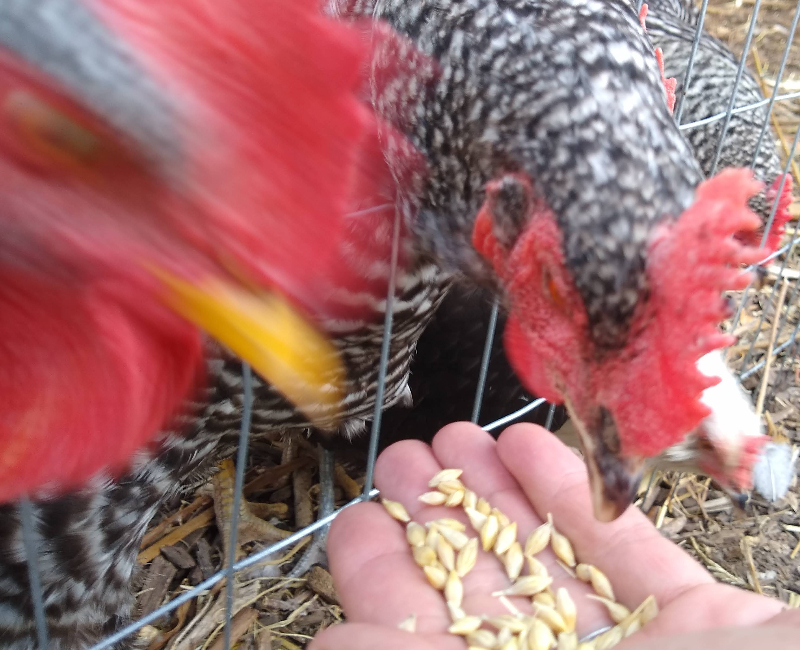
Choose your wheat variety according to how you intend to use it. White Sonora is a variety I have grown a few times because “the hulls are easy to remove without specialized equipment, making it a good option for small garden operations,” as the page at Native Seeds says.
I’ve also grown Pima Club, which is similar to White Sonora. Wheat varieties that are easy to de-hull are often called “hulless” varieties.
Both of these are known as “spring” wheats. You will find wheat varieties being classified as winter or spring types according to when they are grown in locations with colder winters, famous wheat places like Washington, North Dakota, Kansas, and Nebraska. It is said that winter wheat varieties need vernalization, that is, they need to go through a cold winter in order to develop properly. Specifically, a University of Nebraska page says that winter wheats need “exposure for six weeks to temperatures in the 38 to 46 degrees Fahrenheit range.”
But spring wheats don’t need this cold exposure. I have never tried to grow a winter wheat variety in Southern California.
Storing wheat
I store my wheat in a paper bag in my garage and it still germinates well the following year. If you have rodents, you ought to put yours in a plastic or metal bin.
Last summer, I helped my mom move out of her house and found about a dozen white buckets in her garage, all filled with wheat berries. They had been there for over thirty years, stored for an emergency.
Unsealing the buckets, the wheat inside looked to be in perfect condition. But when I sowed three rows of them last winter alongside my other wheat, not a single seed germinated. The wheat berries had looked just like my other wheat berries but they apparently had no life left in them.
This made me wonder if some of the processed foods that we eat are made with such dead wheat. And if so, what kind of nourishment is that for our bodies?
If you eat bread or pasta, you’re not going to be making much of it from the amount of wheat you can grow in a garden. But that’s hardly the point. The point might be to see wheat, and bread and pasta, and history, anew.
Thank you for your support so I can keep the Yard Posts coming and ad-free!
All of my Yard Posts are listed here




That’s cool. I remember being there when a farm family had their wheat crop winnowed by a traveling threshing machine. We still use the word “threshold” for the part under the door that once kept in the threshed grain.
Nice haul Greg,
I tried to grow farro wheat several years ago but had two problems. The first problem was black aphids that infected the wheat with Barley dwarfing virus. Then during may gray and June gloom I got hit with rust. Did you have any of these issues?
Hi Chris,
Luckily, I didn’t. I’ll be growing a couple different varieties this winter so we’ll see if they have any issues.
Luck to you, I’m in a new location now so I’ll try the Sonoran and try to replicate your success.
Dear,
To solve your problem is easy, by trate the seed before planting with insecticide Like Cruiser Syngenta + Fungicide like Dividend from Syngenta or Bayer ). by using these 2 products you will get at least 30 % increment in your yield and cover all your cost.
Great Information, thanks for sharing it! My wife and I used to have and organic CSA farm in Montana and are interested in growing some wheat along with the vegetables we grow in S California. Hopefully we all will be able to help others become more self sufficient growing their own nourishing food. I hope this is a new movement!